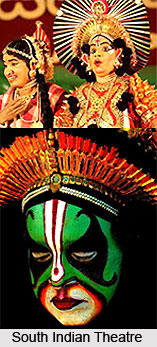Regional Theatre of South India manifests the region based colours of the folk traditions of the south. Malayalam Theatre is of ancient in origin, and is known even though the dramatic literature in Malayalam i.e. the language spoken in southern state of Kerala is of somewhat recent origin. Its oldest extant genre, Kuthiyottam, fully established by the ninth century, may well represent the longest-surviving continuous theatrical tradition in the world. It is a system of staging classical Sanskrit plays, but not entirely Sanskrit theatre in the strict sense because the enactment contains elaborate oral elucidation in Malayalam. Still, it was Kerala`s first performing art based on written texts, and evidently served as a basic model of creative expression for all later forms in Malayalam. Yet it also differs significantly from them in being conventionally presented on raised stages within auditoriums known as Kuttampalam.
 Contemporary Malayalam theatre has a rich heritage behind it, and has indeed come a long way from its past. Just like in any other part of India, Malayalam theatre has also seen a lot of growth in its field. Many theatre enthusiasts and critics felt that the theatre of Kerala did not yield the result as dreamed and expected. Some confusions and perplexity still remain among the people regarding the structure and from of the nature and the medium of production. Some critics are of the opinion that mad experimentation with the themes and plots of the plays have resulted in driving the audiences away.
Contemporary Malayalam theatre has a rich heritage behind it, and has indeed come a long way from its past. Just like in any other part of India, Malayalam theatre has also seen a lot of growth in its field. Many theatre enthusiasts and critics felt that the theatre of Kerala did not yield the result as dreamed and expected. Some confusions and perplexity still remain among the people regarding the structure and from of the nature and the medium of production. Some critics are of the opinion that mad experimentation with the themes and plots of the plays have resulted in driving the audiences away.
Kannada theatre, with all its ancient heritage and rich culture, forms an integral part of the Indian state of Karnataka. Some of the Kannada theatre performances date back to the twelfth century. As far as the folk theatre of Karnataka is concerned, some of the popular folk theatre performances are Yakshagana, Bayalata and Sannata, Talamaddale is a generic variant. The range of theatrical diversity in rural parts of the state also encompasses puppetry. There are two branches, which fall under the term Gombeyata i.e. various forms of ritual possession incorporating worship, such as Bhutaradhane and Karaga. There are also some devotional narratives by and for specific religious sects, as in Kamsale and Viragase.
Tamil theatre is probably the longest linguistic continuity in Indian theatre. With no romanticisation of its ancient origins, one can safely say that remnants and deviations of past traditions find their place in Tamil theatre in different forms. Based on them, one can actually define cultural zones in the southern state of Tamil Nadu by geographical features, occupational aspects, and linguistic clusters. Indeed, ancient Tamil texts classified their land into five regions. These can be mentioned as mountainous, forested, agricultural, coastal and arid.
The ballad traditions have a storyline to offer, the abstract dances have no oral narratives to accompany them, and the narrative forms combine story with performance. Villuppattu and Udukkadippattu are examples of the first, from southern and western Tamil Nadu respectively. In them, local heroes survive and local deities are sung. They contain features that remain on the fringes, not absorbed by any homogenized religious system. Tappattam, Devarattam, Oyilattam, Karagattam, Poykkal Kudhirai, and Kummi belong to the second kind, some with only rhythm and instrumental music, and some with supporting singers. They belong to specific communities following strict feudal orders. The most important among the third category, the thriving Terukkuttu widely prevalent in the northern districts, combines dance, music, plot, dialogue, acting, and costume. Variations can be found in other parts. It is professional in the sense that troupes organize and re-mobilize each year.
Evidence from sculpture and inscriptions indicates that theatrical activities flourished in the present south-eastern state of Andhra Pradesh as early as the second century BC. The Nagarjunakonda excavations laid bare an amphitheatre dated by researchers to the second or third century AD. However, the first definite word of theatre in the Telugu language appears in Palkuriki Somanatha`s poetical texts, Basavapuranamu and Panditaradhya charitramu. He mentions a play, Siriyalu charitra or `Siriyalu`s Story`. This presented with appropriate prelude, correct speech and diction, and proper action during the Sivaratri festival at Srisailam. The only surviving medieval script is Kridabhiramamu or `Graceful Sport` by Vinukonda Vallabharayudu. This was written in the fourteenth century and belongs to the genre of vithi, one of the ten rupakas.
In later days Sanskrit plays were translated in poetic or kavya, but not in dramatic form. However, folk theatre entertained the rural public. During the reign of the Nayaka and Maratha kings based in Thanjavur, Tamil Nadu, Telugu received a boost as their court language. Thus Yakshaganam, which is also called as Vithi Natakam or Bhagavatam, reached its artistic zenith. Tolu Bommalata shadow puppetry, Kuchipudi and Kalapam Voggukatha narrative troupes, Pagati-veshalu, Kuravani dance-drama, Harikatha solo narratives, etc. all these folk forms remained popular for over eight centuries. After the introduction of English education in the nineteenth century, Telugu drama emerged as a distinct literary genre.
It is commonly believed that the first modern Telugu play was Korada Ramachandra Sastry`s Manjari-Madhukariyam i.e. `Tale of Manjari and Madhukara` in 1860. This was a short work with a romantic plot and Sanskritized diction. But no authentic proof exists to validate this claim. The first play may have been Varanasi Dharma Suri`s Narakasura vijaya vyayogamu i.e. `Narakasura`s Victory` in 1871 in the vyayoga genre. This was translated into Telugu by Kokkonda Venkataratnam Pantulu.




